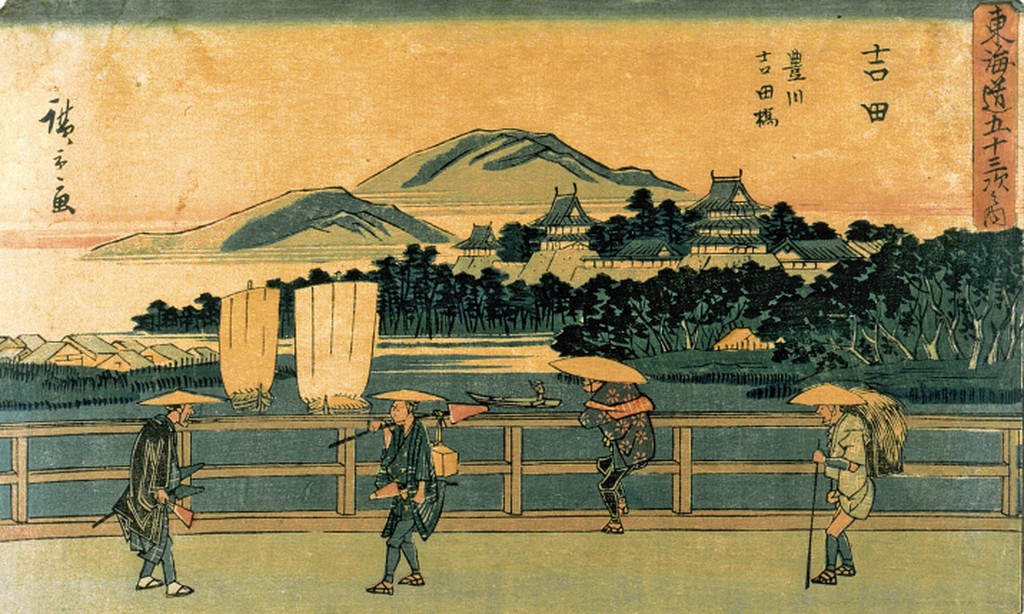
Title: Toyokawa River and Yoshida Bridge
Creator: Utagawa Hiroshige
Period: Edo
Date: 1841-1844
Culture: Japan
Series: The Fifty-three Stations of the Tôkaidô Road
Style: Ukiyo-e
Medium: woodblock print; ink and color on paper
Dimensions:
Repository: Wetmore Print Collection, Art History Dept., Cummings Arts Center, Connecticut College, New London
Credit line: Gift of Prof. Caroline Black, Botany Dept., Connecticut College
ID number: slide# 0065; black078
Additional Notes: Across the Toyokawa River, there seems to be a castle with buildings seen reaching peaks as high as the trees. The irimoya style roofing (slopes down on all four sides) is also present which allows for windows to be protected from rain by the elongated roofing. On the left side of the print, a village can be seen with gassho-zukuri style homes made from wood and straw with a steep thatched roof resembling an open book.
Description
According to the inscription, this is a depiction of the Yoshida Bridge over the Toyokawa River, belonging to one of the Fifty-three Stations of the Tokaido Road, a series done by Hiroshige. Across the Toyokawa River, there seems to be a castle with buildings seen reaching peaks as high as the trees. The irimoya (hip-and-gable roof) is present which allows for windows to be protected from rain by the elongated roofing.
On the left side of the print, a village can be seen with gassho-zukuri style homes made from wood and straw with a steep thatched roof resembling an open book. This stark contrast between the tower-like structures on the right and the village on the left suggests the social realities of Japan during this time. The higher social class is on the right side of the print as they are an enclosed community within a walled complex. The structures watch over the entire landscape as if the rest of society is being looked down upon. The complex is also physically secluded which suggests that it is not only more private, but distanced and segregated from the rest of the society. The tower-like structures resemble pagodas through their emphasis on verticality and square shape, though pagodas are typically found alongside a temple in a Buddhist or Shinto shrine and contain a central pillar. These buildings are on an elevated base, and have acroteria that protrude from the end of the ridgepoles.
This print is from the late Edo period in a time when the society was rapidly developing. Rural environments were turning more urban, but not all parts of the society would progress. The same social class that divides the two sides of this print would continue to widen as they would move into the 20th century. The bridge is perhaps a symbolic reference to this divide; it connects both sides, but does not connect the two societies.
References
Hiroshige, Japanese. Toyokawa River and Yoshida Bridge. color woodcut. Place: Wetmore Print Collection, Art History Dept, Cummings Arts Center, Connecticut College, New London, Donated by Prof. Caroline Black, Botany Dept, Connecticut College. https://library.artstor.org/asset/CONNASIAN_106310758469 (access to Artstor required).
“The Fifty-Three Stations of the Tōkaidō Road .” The Woodblock Prints of Utagawa Hiroshige, www.hiroshige.org.uk/Tokaido_Series/Tokaido_Series.htm.
“Utagawa Hiroshige: Yoshida: Toyokawa River and Yoshida Bridge (Yoshida, Toyokawa Yoshida-Bashi), from the Series The Fifty-Three Stations of the Tôkaidô Road (Tôkaidô Gojûsan Tsugi No Uchi), Also Known as the Gyôsho Tôkaidô – Museum of Fine Arts.” Ukiyo, ukiyo-e.org/image/mfa/sc133795.
Wachtmeister, Jesper. Kochuu. Danish Broadcasting Corporation, 2003.
“Gassho-Zukuri .” World Heritage, shirakawa-go.org/english/e_world.html.
1 thought on “Toyokawa River and Yoshida Bridge”